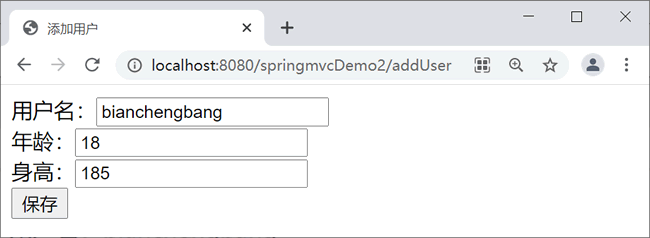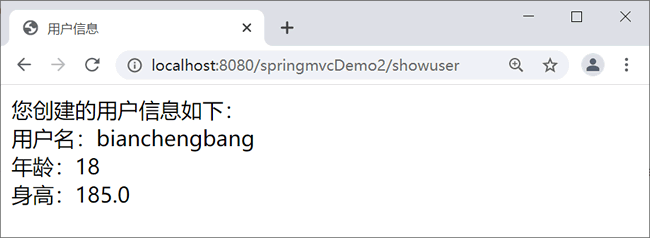首页 > 编程笔记
Spring MVC表单标签库
我们在进行 Spring MVC 项目开发时,一般会使用 EL 表达式和 JSTL 标签来完成页面视图的开发。其实 Spring 也有自己的一套表单标签库,通过 Spring 表单标签,可以很容易地将模型数据中的命令对象绑定到 HTML 表单元素中。下面我们就通过一个示例来演示该标签库的用法。
首先和 JSTL 标签的使用方法相同,在使用 Spring 表单标签之前,必须在 JSP 页面开头处声明 taglib 指令,指令代码如下。
常用的 Spring 表单标签如下表所示。
以上标签基本都拥有以下属性。
此外,表单组件标签页拥有 HTML 标签的各种属性,如 id、onclick 等,都可以根据需要灵活使用。
创建显示页面 showUser.jsp,代码如下。

添加用户

显示添加用户信息
首先和 JSTL 标签的使用方法相同,在使用 Spring 表单标签之前,必须在 JSP 页面开头处声明 taglib 指令,指令代码如下。
<%@ taglib prefix="fm" uri="http://www.springframework.org/tags/form"%>
常用的 Spring 表单标签如下表所示。
| 名称 | 作用 |
|---|---|
| form | 渲染表单元素 |
| input | 输入框组件标签,渲染 <input type="text"/> 元素 |
| password | 密码框组件标签,渲染 <input type="password"/> 元素 |
| hidden | 隐藏框组件标签,渲染 <input type="hidden"/> 元素 |
| textarea | 多行输入框组件标签,渲染 textarea 元素 |
| checkbox | 复选框组件标签,渲染一个 <input type="checkbox"/> 元素 |
| checkboxes | 渲染多个 <input type="checkbox"/> 元素 |
| radiobutton | 单选框组件标签,渲染一个 <input type="radio"/> 元素 |
| radiobuttons | 渲染多个 <input type="radio"/> 元素 |
| select | 下拉列表组件标签,渲染一个选择元素 |
| option | 渲染一个选项元素 |
| options | 渲染多个选项元素 |
| errors | 显示表单数据校验所对应的错误信息 |
- path:属性路径,表示表单对象属性,如 userName、userCode 等。
- cssClass:表单组件对应的 CSS 样式类名。
- cssErrorClass:当提交表单后报错(服务端错误),采用的 CSS 样式类。
- cssStyle:表单组件对应的 CSS 样式。
- htmlEscape:绑定的表单属性值是否要对 HTML 特殊字符进行转换,默认为 true。
示例
下面以 <fm:form> 表单标签为例,模仿添加用户信息。1. 创建实体类
创建实体类 user,代码如下。
package net.biancheng.po;
public class User {
private String name;
private Integer age;
private Double height;
/** 省略setter和getter方法*/
}
2. 创建页面
创建 addUser.jsp,代码如下。
<%@ page language="java" contentType="text/html; charset=UTF-8"
pageEncoding="UTF-8"%>
<%@ taglib prefix="fm" uri="http://www.springframework.org/tags/form"%>
<!DOCTYPE html PUBLIC "-//W3C//DTD HTML 4.01 Transitional//EN" "http://www.w3.org/TR/html4/loose.dtd">
<html>
<head>
<meta http-equiv="Content-Type" content="text/html; charset=UTF-8">
<title>添加用户</title>
</head>
<body>
<fm:form method="post" modelAttribute="user" action="${pageContext.request.contextPath }/showuser">
用户名:<fm:input path="name"/>
<br />
年龄:<fm:input path="age"/>
<br />
身高:<fm:input path="height"/>
<br />
<input type="submit" value="保存" />
</fm:form>
</body>
</html>
<fm:form> 标签的 modelAttribute 属性用于指定绑定的模型属性。默认从模型中尝试取名为“command”的表单对象,若不存在此表单对象,将会报错。所以一般情况下会指定 modelAttribute 属性。此外,表单组件标签页拥有 HTML 标签的各种属性,如 id、onclick 等,都可以根据需要灵活使用。
创建显示页面 showUser.jsp,代码如下。
<%@ page language="java" contentType="text/html; charset=UTF-8"
pageEncoding="UTF-8"%>
<!DOCTYPE html PUBLIC "-//W3C//DTD HTML 4.01 Transitional//EN" "http://www.w3.org/TR/html4/loose.dtd">
<html>
<head>
<meta http-equiv="Content-Type" content="text/html; charset=UTF-8">
<title>用户信息</title>
</head>
<body>
您创建的用户信息如下:
<br />
<!-- 使用EL表达式取出model中的user信息 -->
用户名:${user.name }
<br /> 年龄:${user.age }
<br /> 身高:${user.height }
</body>
</html>
3. 创建控制器类
创建 UserController,代码如下。
package net.biancheng.controller;
import javax.servlet.http.HttpServletRequest;
import javax.servlet.http.HttpSession;
import org.springframework.stereotype.Controller;
import org.springframework.web.bind.annotation.ModelAttribute;
import org.springframework.web.bind.annotation.PathVariable;
import org.springframework.web.bind.annotation.RequestMapping;
import org.springframework.web.bind.annotation.RequestMethod;
import net.biancheng.po.User;
@Controller
public class UserController {
@RequestMapping(value = "/addUser", method = RequestMethod.GET)
public String add(@ModelAttribute("user") User user) {
return "addUser";
}
@RequestMapping(value = "/showuser", method = RequestMethod.POST)
public String showuser(User user, HttpSession session, HttpServletRequest request) {
return "showUser";
}
}
4. 测试运行
访问地址:http://localhost:8080/springmvcDemo2/addUser,运行结果如下图所示。
添加用户

显示添加用户信息
